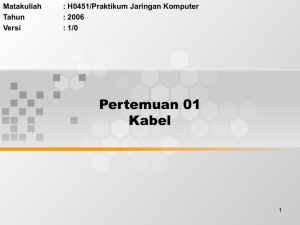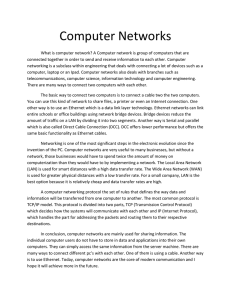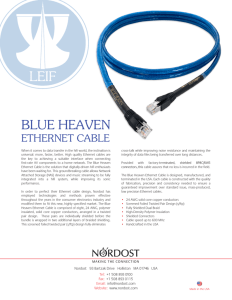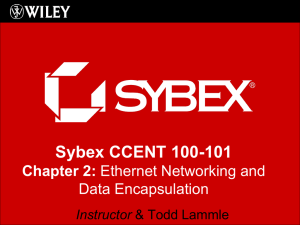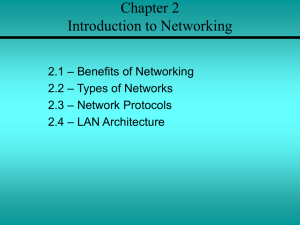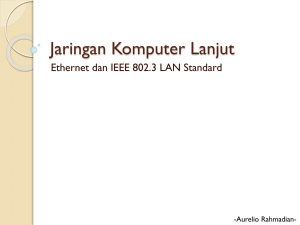KIS – Cvičenie #1
advertisement
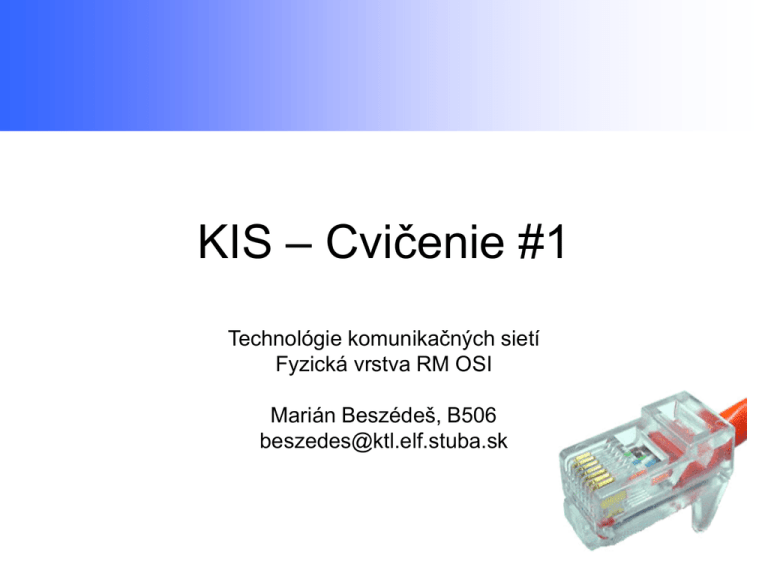
KIS – Cvičenie #1 Technológie komunikačných sietí Fyzická vrstva RM OSI Marián Beszédeš, B506 beszedes@ktl.elf.stuba.sk Kis - Program cvičení • • • • • • • • • • • • 1. 2. 3. 4. 5. 6. 7. 8. 9. 10. 11. 12. Úvod, technológie komunikačných sietí Ethernet, MAC podvrstva Analýza prevádzky na sieti Ethernet Návrh LAN siete IP konfigurácia v prostredí OS Windows (+zadanie referátov) Sieťovanie LAN a WAN CBT Manažment IP sietí Test, príprava referátu WAN: ISDN Prezentácia referátu Prezentácia referátu, zápočet KIS – Podmienky / Hodnotenie • Podmienky získania zápočtu – aktívna účasť na cvičeniach – žiadna neospravedlnená absencia na cvičeniach – max. dve absencie s lekárskym potvrdením o práceneschopnosti. • Hodnotenie: – za cvičenia je možné získať max. 40 bodov, – na získanie zápočtu je potrebných min. 20 bodov, – body sú prideľované na základe kontrolného testu (max. 15 bodov), referátu (max. 15 bodov) a aktivity (max. 10 bodov). RM OSI = Reference Model Open Systems Interconnection Physical Layer RMOSI • This layer conveys the bit stream – electrical impulse – Light – radio signal through the network at the electrical and mechanical level. • It provides the hardware means of sending and receiving data on a carrier, including defining cables, cards and physical aspects. Ethernet = Physical, Datalink Layer • Ethernet is a frame-based computer networking technology for local area networks (LANs). (since 1976) • Defines: – wiring and signaling for the physical layer – frame formats and protocols (MAC Media access control, Logical Link Control) for the data link layer The Ethernet Physical Layers • Ethernet devices – implement only the bottom two layers of the OSI Model – they are typically implemented as network interface cards –NICs – plug into the host device's motherboard. • Naming convention – 10Base-T = 10 Mbps, baseband, over two twisted-pair cables – 100Base-T2 = 100 Mbps, baseband, over two twisted-pair cables – 100Base-T4 = 100 Mbps, baseband, over four-twisted pair cables – 1000Base-LX = 100 Mbps, baseband, long wavelength over optical fiber cable Thin Ethernet (10base2) • (Cheapernet) is based on using a coax-cable, which is specified as RG58 (50 Ohm) • 50 Ohm terminator on each end • One terminator MUST be grounded, the other NOT ! Thin Ethernet (10base2) • cable is connected via BNCT-connectors directly to the network card installed in the PC Thin Ethernet (10base2) • • BUS Topology Each connection to an Thin-Ethernet RG-58 cable is called a "node„ (PC, UNIX-workstation, fileserver, network printers,...). • Limitations – maximum 30 nodes on one Thin-Ethernet segment – minimum 0.5 meter distance between nodes – maximum total cable-length of 185 meter Thick Ethernet (10base5) • cable (single central wire, plastic insulation, In turn surrounded by four shields, outside jacket) • 255 nodes • each node must be at least 2.5 meters • up to 500 meters Twisted Pair Ethernet (10baseT/UTP) • UTP - Unshielded Twisted Pair cable is connected via an RJ-45 connectors to the network card installed in the PC • UTP cables connect now each PC to the "hub„ - amplifies and distributes the signal to other connected systems Cable types UTP categories Category 1 Voice Only (Telephone Wire) Category 2 Data to 4 Mbps (LocalTalk) Category 3 Data to 10 Mbps (Ethernet) Category 4 Data to 20 Mbps (16 Mbps Token Ring) Category 5 Data to 100 Mbps (Fast Ethernet) RJ45 must be shielded too Crossover 10baseT • Crossover: – PC – PC – Hub – Hub • Some hubs offer special connectors : – "Uplink" or something like "MDI/X„ = Straight / Crossower 10BaseT - Network • Star Topology • Limitations: – Maximum segment length 100 meters – Minimum between computers 2.5 meters – 1024 nodes maximum on the LAN – 4 repeater / 5 segment rule of 10Base5 is retained 10BaseT - Larger networks Twisted Pair versus Coax: Reliability / Advantages • What happens, when the cable breaks ? • What happens, when PC added to a network ? Coax cable can only be used on 10 MHz networks, while Twisted-Pair using CAT5cabling is also able to handle 100 MHz networks. Fast Ethernet (100baseT) 100Base-TX • 100BASE-TX -- Similar star-shaped configuration to 10BASE-T. It also uses two pairs, but requires Cat-5 cable to achieve 100Mbit/s. • 100BASE-T4 -- 100 Mbit/s Ethernet over Cat-3 cabling, 4 pairs (as used for 10BASE-T installations) • 100BASE-FX: 2 fiber optic cables 10 Mhz or 100 Mhz : Dual-Speed Hubs 100Base-T4 Gigabit Ethernet (1000BaseT) • UTP Cat 5e ("Category 5 enhanced"), UTP Cat 6 Cable (No need to rewire network !!!) • It uses all four cable pairs for simultaneous transmission in both directions (echo cancellation, …) Gigabit Ethernet (1000BaseT) Types of wiring: • • • • • 1000BASE-SX (a short laser wavelength on multimode fiber optic cable for a maximum length of 550 meters) 1000BASE-LX/LH (a long wavelength for a "long haul" fiber optic cable for a maximum length of 10 kilometers) 1000BASE-ZX (an extended wavelength single-mode optical fiber for up to 100 kilometers) 1000BASE-CX (two pairs of 150-ohm shielded twisted pair cable for a maximum length of 25 meters) 1000BASE-T (four pairs of Category 5 Unshielded Twisted Pair cable for a maximum length of 100 meters (e.g. 90 m horizontal (inside the building), 9 m at the patch panel, and 1 m from the port to the computer or node)) Computer networking devices Networks have the trend to grow : • Repeater / Hub (Multiport repeater)/ • Switch / Bridge • Router Network Repeater / Hub 10Base2 10BaseT (TP/UTP) Network Repeater / Hub Limitations Repeaters / Hubs are 'non-intelligent' devices • whatever comes in on one port, gets amplified and send out to ALL other ports • any network transmission 'fills up/flows into' ALL cable-segments of the network • only ONE network connection can be active at a time on the complete network ! Network Repeater / Hub Limitations Network Bridge • more 'intelligent' device • viewed at the data inside the transmissions, to find out based on the Network-card addresses (MAC), whether it is necessary to transmit the information to a different segment or not • only 2 connectors, allowing to split large networks into 2 smaller sub-networks (collision domains). Network Switch • Even more 'intelligent‘ device • able to handle more than 2 ports and are able to handle more than 2 communications at the same time • When a transmission comes in on one port, the switch looks at the MAC addresses to determine, onto which port to send it out Network Switch Network Router • A router is a computer networking device that forwards data packet across an internetwork toward their destinations, through a process known as routing. • Divides network into broadcast domains: – A broadcast domain is a logical area in a computer network where any computer connected to the computer network can directly transmit to any other in the domain without having to go through a routing device Router-Switch and Neighborhood Analogy References • • • • www.windowsnetworking.com www.wikipedia.org www.cisco.com www.ethermanage.com

